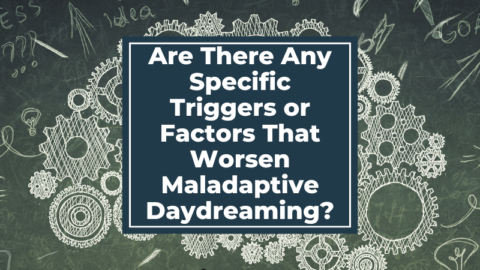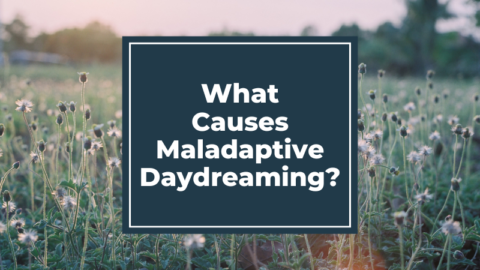Maladaptive daydreaming, characterized by excessive and immersive daydreaming that interferes with daily functioning, is a phenomenon that has garnered increasing attention in recent years. As individuals grapple with its impact on their lives, a common question arises: Is maladaptive daydreaming a lifelong condition, or can it be overcome with time and effort?
While there is ongoing research and limited empirical evidence on the long-term trajectory of maladaptive daydreaming, perspectives among professionals vary. Some believe that maladaptive daydreaming can persist throughout a person’s life, requiring ongoing management and self-awareness. Others maintain a more optimistic view, suggesting that with the right interventions and strategies, individuals can learn to reduce its influence and regain control over their lives.
In my personal experience, I do believe maladaptive daydreaming can be overcome. After suffering from maladaptive daydreaming from as young as I can continue until well into my adult years, I was finally able to come to terms with my unhealthy coping methods, and after several years of effort, I can happily report that I have not maladaptive daydreamed for years.
Exploring the question of whether maladaptive daydreaming is a lifelong condition involves examining factors such as your level of engagement, underlying psychological factors, and the effectiveness of therapeutic approaches. It is crucial to recognize that each person’s experience with maladaptive daydreaming is unique, and outcomes may differ based on various personal circumstances. Just because I was able to overcome my maladaptive daydreaming does not mean definitely that everyone can. However, I think that it’s likely most people can.
In this article, we will delve into the current understanding of maladaptive daydreaming and its potential longevity. We will explore the perspectives of professionals, consider factors that may influence the course of maladaptive daydreaming, and discuss strategies that individuals can employ to manage its impact on their lives. By shedding light on this topic, we aim to provide valuable insights and empower individuals in their journey toward understanding and navigating maladaptive daydreaming.
Note: It is important to consult with mental health professionals for personalized guidance and support in addressing maladaptive daydreaming and its impact on your well-being.
Is Maladaptive Daydreaming a Lifelong Condition?
Maladaptive daydreaming can vary in duration and intensity among individuals. For some people, maladaptive daydreaming may be a lifelong challenge that requires ongoing management and coping strategies. However, it is important to note that the severity and impact of maladaptive daydreaming can fluctuate over time, and individuals may experience improvements or periods of remission.
Through self-awareness, therapy, and the development of healthy coping mechanisms, individuals can learn to better manage their maladaptive daydreaming tendencies. With time, effort, and appropriate support, it is possible for individuals to reduce the negative impact of maladaptive daydreaming on their daily lives.
Here are some additional points to consider regarding the lifelong nature and potential for improvement in maladaptive daydreaming:
- Lifelong Management: While maladaptive daydreaming may persist throughout a person’s life, it does not mean that it will necessarily dominate or define their entire existence. With appropriate strategies and support, individuals can learn to manage their daydreaming tendencies and reduce the negative impact on their daily functioning. I believe that identifying your maladaptive daydreaming triggers is a crucial step in learning to overcome your maladaptive daydreaming tendencies.
- Individual Differences: The course of maladaptive daydreaming can vary significantly from person to person. Some individuals may find that their daydreaming patterns naturally diminish over time, while others may need to actively work on developing coping mechanisms and maintaining awareness of their daydreaming behaviors. No two people are the same, so you shouldn’t expect that your journey with maladaptive daydreaming will or should be like anyone else’s.
- Treatment and Therapy: Seeking professional help, such as therapy or counseling, can be beneficial in understanding and managing maladaptive daydreaming. Therapists experienced in treating maladaptive daydreaming can provide guidance, support, and evidence-based techniques to help individuals gain better control over their daydreaming tendencies.
- Lifestyle Factors: Lifestyle changes, such as establishing a structured routine, engaging in regular physical activity, practicing mindfulness, and finding healthy outlets for creativity, actively working on areas in life you find lacking and distressing, can contribute to managing maladaptive daydreaming. Taking care of one’s overall well-being, including physical, mental, and emotional health, can positively impact daydreaming tendencies.
- Self-Awareness and Mindfulness: Developing self-awareness around triggers, patterns, and emotions associated with daydreaming can be helpful in managing maladaptive daydreaming. By cultivating mindfulness, individuals can learn to redirect their focus and attention away from excessive daydreaming and engage more fully in the present moment.
- Continued Growth and Adaptation: Managing maladaptive daydreaming is an ongoing process of learning, self-reflection, and growth. It may involve identifying triggers, understanding underlying emotions, and developing healthy coping mechanisms. Continuous self-reflection and seeking new strategies or resources can contribute to continuous improvement and overall well-being. As individuals with maladaptive daydreaming learn more about their condition and develop coping mechanisms, they can continue to grow and adapt their strategies over time. What works at one point in their journey may evolve as they gain more insights and experience.
- External Support Systems: Building a strong support network can be valuable in managing maladaptive daydreaming. Trusted friends, family members, or support groups can provide understanding, encouragement, and accountability. Connecting with others who have similar experiences can be particularly helpful in finding validation and learning from shared experiences.
- Combination Approaches: The treatment and management of maladaptive daydreaming often involve a combination of approaches. This may include therapy, such as cognitive-behavioral therapy (CBT), mindfulness techniques, self-help resources, and lifestyle modifications. The effectiveness of different strategies can vary from person to person, so it is essential to explore and find the right combination that works best for each individual.
- Personal Resilience: Recognizing and celebrating personal resilience is crucial in the journey of managing maladaptive daydreaming. While it may present challenges, individuals who are resilient can adapt and thrive despite these challenges. I have several siblings. While we all lived through similar circumstances, there is a huge difference in how well we were each able to overcome our pasts and create a healthy future. We’re all doing better than we were, however, some of us are getting there faster than others. Cultivating resilience involves developing self-compassion, perseverance, and a willingness to seek support when needed.
- Education and Research: Staying informed about the latest research and developments in understanding maladaptive daydreaming can provide valuable insights and new strategies for management. Keeping up with reputable sources, academic studies, and professional publications can contribute to personal growth and enhance understanding. I always believe that you should take charge of your own health. Study up on techniques to gain personal insights and bring up relevant topics with your professionals and support groups.
- Holistic Approach: If you’re not ready to or can’t afford to seek professional treatment right now, taking a holistic approach to managing maladaptive daydreaming can be beneficial. This involves addressing not only the daydreaming itself but also addressing underlying emotional, psychological, and lifestyle factors. Incorporating practices such as self-care, stress management, and healthy coping mechanisms can support overall well-being and contribute to better daydreaming management.
- Supportive Environment: Creating a supportive environment that promotes healthy habits and behaviors can be instrumental in managing maladaptive daydreaming. This includes setting realistic expectations, establishing boundaries, and surrounding oneself with people who understand and respect one’s challenges and goals. You shouldn’t have to hide your maladaptive daydreaming from people that love you. Be open with them and allow them to support you on your journey.
- Positive Mindset: Maintaining a positive mindset and cultivating resilience can greatly contribute to managing maladaptive daydreaming. Embracing a growth mindset and focusing on progress rather than perfection can help navigate the ups and downs of the journey. Celebrating small victories and practicing self-compassion along the way can foster a positive and empowering mindset.
- Psychological Dependence: Maladaptive daydreaming often serves as an emotional coping mechanism or a means of escape from real-life difficulties. It can provide comfort, control, and temporary relief from stress, anxiety, or other emotional challenges. Breaking free from this dependence requires finding alternative, healthier coping mechanisms and addressing the underlying emotional needs that drive excessive daydreaming.
- Reinforcement and Habitual Patterns: Maladaptive daydreaming can become reinforced over time through repetition and reinforcement mechanisms in the brain. The brain’s reward system may respond to the pleasurable feelings associated with daydreaming, making it difficult to break the cycle. Additionally, daydreaming can become a deeply ingrained habit, making it challenging to consciously redirect attention and break the automatic patterns. Some people believe that maladaptive daydreaming becomes an addiction, and like all addictions, will take effort to overcome.
- Emotional Attachment and Identification: Maladaptive daydreaming can become closely tied to an individual’s sense of identity, as it provides a way to explore fantasies, emotions, and desires. It can be challenging to let go of daydreaming when it has become a significant part of one’s inner world and self-perception. Addressing and reframing the emotional attachment to daydreaming can be crucial in facilitating change.
- Lack of Awareness and Control: Many individuals with maladaptive daydreaming struggle with a lack of awareness or control over their daydreaming episodes. It can feel involuntary or automatic, making it difficult to interrupt or regulate. Building self-awareness, recognizing triggers, and developing strategies to regain control over daydreaming can be key to overcoming its grip. For the years that I struggled with maladaptive daydreaming, I refused to acknowledge that it was hindering me. I felt that my “circle walking” that induced daydreams was like exercise that was just helping me deal with stress. I didn’t even hear the term maladaptive daydreaming until my late twenties. Once I did, it felt like everything clicked into place, I recognized that I had a problem, and was finally able to start my journey to overcome it.
- Underlying Emotional and Psychological Factors: Maladaptive daydreaming often coexists with other emotional or psychological challenges such as anxiety, depression, trauma, or attention difficulties. Addressing these underlying factors through therapy, counseling, or other appropriate interventions can contribute to breaking free from maladaptive daydreaming patterns.
Everyone’s journey with maladaptive daydreaming is unique, and the trajectory of improvement or recovery can vary from person to person. It is important to approach the management of maladaptive daydreaming with patience, self-compassion, and the understanding that progress may occur gradually. Seeking professional help from mental health practitioners experienced in treating maladaptive daydreaming can provide guidance and support throughout this process.
Ultimately, while maladaptive daydreaming may present ongoing challenges, with proactive management and support, individuals can strive for greater control over their daydreaming tendencies and experience improvements in their overall well-being.
Do Professionals Believe Maladaptive Daydreaming is a Lifelong Condition?
The perspective of professionals regarding whether maladaptive daydreaming is a lifelong condition seems to vary. Since maladaptive daydreaming is a relatively new area of study and not a formally recognized psychological condition, there is ongoing research and discussion about its long-term trajectory. Some professionals believe that maladaptive daydreaming can persist throughout a person’s life, especially if it is deeply ingrained and has become a habitual coping mechanism. They suggest that while the intensity and impact of maladaptive daydreaming may fluctuate over time, it may require ongoing management and self-awareness.
However, other professionals are optimistic about the potential for improvement and recovery. They believe that with the right interventions, individuals can learn to manage and reduce maladaptive daydreaming symptoms, leading to significant improvement in functioning and overall well-being. Through therapy, counseling, and developing healthy coping strategies, individuals can gain control over their daydreaming patterns and learn to redirect their focus toward real-life goals and activities. I tend to side with these experts based on my own personal experience.
Why Is It So Hard to Stop Maladaptive Daydreaming?
Stopping maladaptive daydreaming can be challenging due to various factors:
- Psychological Dependence: Maladaptive daydreaming often serves as an emotional coping mechanism or a means of escape from real-life difficulties. It can provide comfort, control, and a temporary relief from stress, anxiety, or other emotional challenges. Breaking free from this dependence requires finding alternative, healthier coping mechanisms and addressing the underlying emotional needs that drive excessive daydreaming.
- Reinforcement and Habitual Patterns: Maladaptive daydreaming can become reinforced over time through repetition and reinforcement mechanisms in the brain. The brain’s reward system may respond to the pleasurable feelings associated with daydreaming, making it difficult to break the cycle. Additionally, daydreaming can become a deeply ingrained habit, making it challenging to consciously redirect attention and break the automatic patterns.
- Emotional Attachment and Identification: Maladaptive daydreaming can become closely tied to an individual’s sense of identity, as it provides a way to explore fantasies, emotions, and desires. It can be challenging to let go of daydreaming when it has become a significant part of one’s inner world and self-perception. Addressing and reframing the emotional attachment to daydreaming can be crucial in facilitating change.
- Lack of Awareness and Control: Many individuals with maladaptive daydreaming struggle with a lack of awareness or control over their daydreaming episodes. It can feel involuntary or automatic, making it difficult to interrupt or regulate. Building self-awareness, recognizing triggers, and developing strategies to regain control over daydreaming can be key to overcoming its grip.
- Underlying Emotional and Psychological Factors: Maladaptive daydreaming often coexists with other emotional or psychological challenges such as anxiety, depression, trauma, or attention difficulties. Addressing these underlying factors through therapy, counseling, or other appropriate interventions can contribute to breaking free from maladaptive daydreaming patterns.
Overcoming maladaptive daydreaming is a process that takes time, self-reflection, and effort. Seeking professional help from mental health practitioners experienced in treating maladaptive daydreaming can provide guidance, support, and specific strategies tailored to individual needs. With dedication, self-awareness, and appropriate support, it is possible to gradually reduce the hold of maladaptive daydreaming and regain control over one’s thoughts and behaviors.
How Can You Stop Maladaptive Daydreaming Once and For All?
Stopping maladaptive daydreaming entirely can be challenging, but with dedication and a comprehensive approach, it is possible to manage and reduce its impact. Here are some strategies that may help:
- Awareness and Self-Reflection: Develop self-awareness of your daydreaming patterns, triggers, and the emotional needs they fulfill. Recognize when you are engaging in maladaptive daydreaming and what purpose it serves for you. This awareness can help you interrupt the cycle and redirect your focus. As I mentioned earlier, becoming aware of my maladaptive daydreaming problem was key to starting my recovery.
- Healthy Coping Mechanisms: Identify and practice healthy coping mechanisms that address the underlying emotions and needs that drive maladaptive daydreaming. This may include engaging in mindfulness exercises, relaxation techniques, creative outlets, or pursuing real-life goals and activities that provide fulfillment.
- Therapy and Counseling: Seek professional help from therapists or counselors experienced in treating maladaptive daydreaming. They can provide guidance, support, and specific strategies tailored to your needs. Cognitive-behavioral therapy (CBT) and other therapeutic modalities may be effective in helping you gain control over daydreaming and develop healthier thought patterns.
- Structured Routine and Goals: Establish a structured routine and set realistic goals to create a sense of purpose and fulfillment in your daily life. Having clear objectives and engaging in meaningful activities can reduce the desire to escape into excessive daydreaming.
- External Support Systems: Build a support network of trusted individuals who can provide understanding, encouragement, and accountability. Seek support groups or online communities where you can connect with others who have similar experiences. Sharing your journey with others can provide validation, insights, and motivation.
- Gradual Reduction: Rather than aiming for an immediate cessation of maladaptive daydreaming, focus on gradually reducing the frequency and duration of episodes. Set small, achievable goals and celebrate each milestone along the way. Consistency and perseverance are key. I don’t know of anyone who was able to quit maladaptive daydreaming overnight.
- Patience and Self-Compassion: Recognize that overcoming maladaptive daydreaming is a process that takes time and effort. Be patient with yourself and practice self-compassion. Accept that there may be setbacks or relapses along the way and use them as learning opportunities to further refine your strategies.
In Conclusion:
The question of whether maladaptive daydreaming is a lifelong condition remains complex and multifaceted. While there is still much to learn about its long-term trajectory, there is reason to believe that individuals can work towards managing and reducing its influence on their lives. Through self-awareness, therapy, and the implementation of healthy coping strategies, individuals can take steps toward regaining control over excessive daydreaming and finding a balance that allows for greater fulfillment in real-life experiences. Continued research and open dialogue will contribute to a deeper understanding of maladaptive daydreaming and the potential for positive change in the lives of those affected by it.
To connect with other Maladaptive daydreamers and share your recovery stories, join the Maladaptive Daydreaming Forum.










There’s definately a great deal to learn about this topic.
I like all of the points you have made.